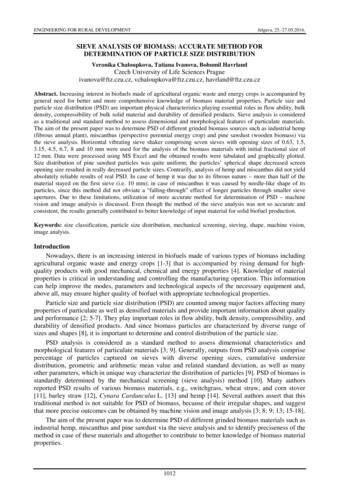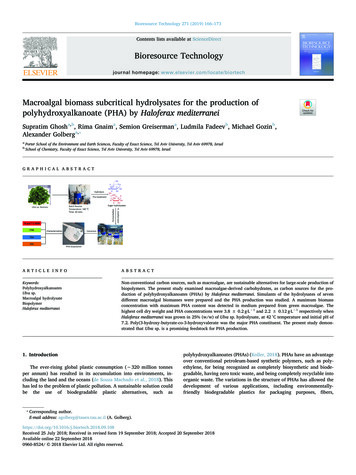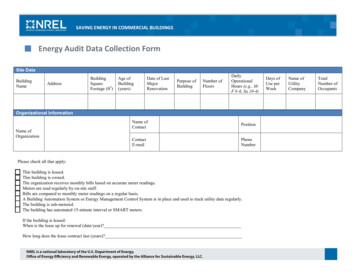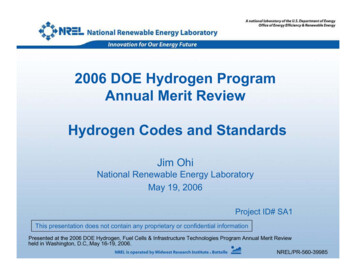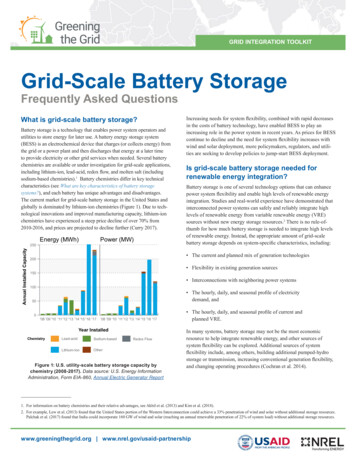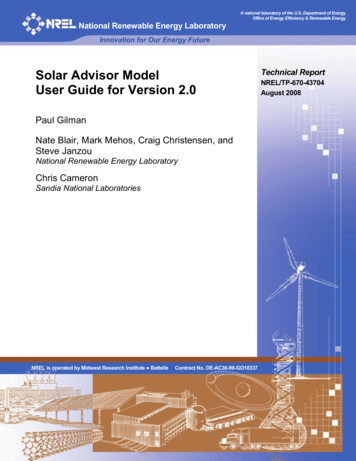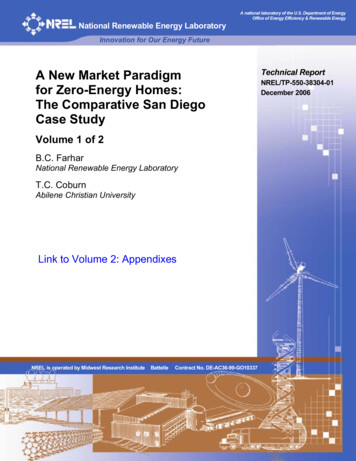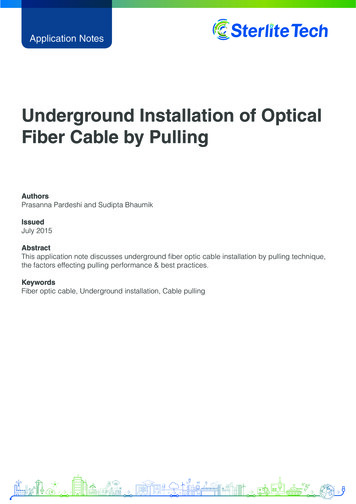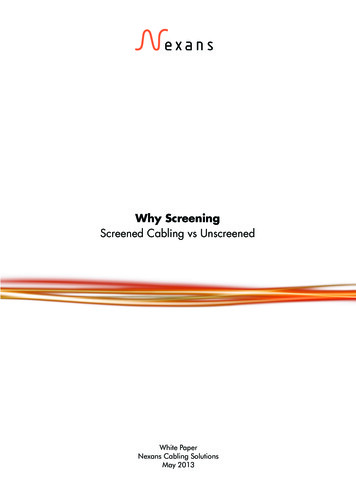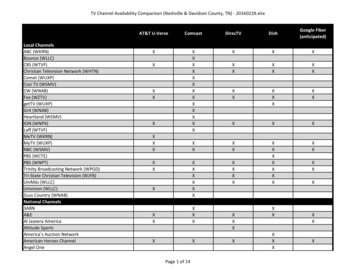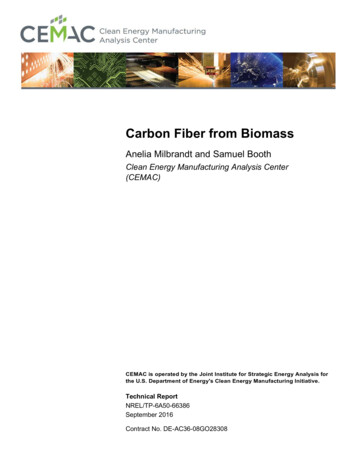
Transcription
Carbon Fiber from BiomassAnelia Milbrandt and Samuel BoothClean Energy Manufacturing Analysis Center(CEMAC)CEMAC is operated by the Joint Institute for Strategic Energy Analysis forthe U.S. Department of Energy's Clean Energy Manufacturing Initiative.Technical ReportNREL/TP-6A50-66386September 2016Contract No. DE-AC36-08GO28308
Carbon Fiber from BiomassAnelia Milbrandt and Samuel BoothClean Energy Manufacturing Analysis Center(CEMAC)Prepared under Task No. AM05.5820CEMAC is operated by the Joint Institute for Strategic Energy Analysis for the U.S.Department of Energy's Clean Energy Manufacturing Initiative.Clean Energy ManufacturingAnalysis Center15013 Denver West ParkwayGolden, CO echnical ReportNREL/TP-6A50-66386September 2016Contract No. DE-AC36-08GO28308
NOTICEThis report was prepared as an account of work sponsored by an agency of the United Statesgovernment. Neither the United States government nor any agency thereof, nor any of their employees,makes any warranty, express or implied, or assumes any legal liability or responsibility for the accuracy,completeness, or usefulness of any information, apparatus, product, or process disclosed, or representsthat its use would not infringe privately owned rights. Reference herein to any specific commercialproduct, process, or service by trade name, trademark, manufacturer, or otherwise does not necessarilyconstitute or imply its endorsement, recommendation, or favoring by the United States government or anyagency thereof. The views and opinions of authors expressed herein do not necessarily state or reflectthose of the United States government or any agency thereof.Available electronically at SciTech Connect: http:/www.osti.gov/scitechAvailable for a processing fee to U.S. Department of Energyand its contractors, in paper, from:U.S. Department of EnergyOffice of Scientific and Technical InformationP.O. Box 62Oak Ridge, TN 37831-0062OSTI http://www.osti.govPhone: 865.576.8401Fax: 865.576.5728Email: reports@osti.govAvailable for sale to the public, in paper, from:U.S. Department of CommerceNational Technical Information Service5301 Shawnee RoadAlexandria, VA 22312NTIS http://www.ntis.govPhone: 800.553.6847 or 703.605.6000Fax: 703.605.6900Email: orders@ntis.govCover Photos: (left to right) iStock 2225189; iStock 16687273; Oak Ridge National Laboratory; iStock 24304597; iStock 26005993;iStock 2069560NREL prints on paper that contains recycled content
AcknowledgmentsWe would like to thank Joe Cresko and Brian Walker from the U.S. Department of Energy’sAdvanced Manufacturing Office (AMO) and Margaret Mann from the National RenewableEnergy Laboratory (NREL) for their support and guidance throughout this project. Special thanksgo to Mary Biddy from NREL for providing an estimate of carbon fiber production fromlignocellulosic sugars, as well as for her review and valuable recommendations. We also thankSujit Das from Oak Ridge National Laboratory, Jill Engel-Cox from the Clean EnergyManufacturing Analysis Center, and Brandon Hoffman from Allegheny Science and TechnologyCorporation for their review and helpful suggestions.iii
Nomenclature and onnestonsacrylonitrileBritish thermal unitsCo-solvent Enhanced Lignocellulosic Fractionationcarbon fibergamma valerolactonepoundmegajoule ( 948 Btu)polyacrylonitrilethe starting material used to make carbon fiberSequential Liquid-Lignin Recovery and Purificationsolid rocket motortetrahydrofuranmetric tonsshort tonsiv
Executive SummaryCarbon fiber (CF), known also as graphite fiber, is a lightweight, strong, and flexible materialused in both structural (load-bearing) and non-structural applications (e.g., thermal insulation).The high cost of precursors (the starting material used to make CF, which comes predominatelyfrom fossil sources) and manufacturing have kept CF a niche market with applications limitedmostly to high-performance structural materials (e.g., aerospace). Alternative precursors toreduce CF cost and dependence on fossil sources have been investigated over the years,including biomass-derived precursors such as rayon, lignin, glycerol, and lignocellulosic sugars.The purpose of this study is to provide a comprehensive overview of CF precursors frombiomass and their market potential. We examine the potential CF production from theseprecursors, the state of technology and applications, and the production cost (when data areavailable). We discuss their advantages and limitations. We also discuss the physical propertiesof biomass-based CF, and we compare them to those of polyacrylonitrile (PAN)-based CF. Wealso discuss manufacturing and end-product considerations for bio-based CF, as well asconsiderations for plant siting and biomass feedstock logistics, feedstock competition, and riskmitigation strategies. The main contribution of this study is that it provides detailed technicaland market information about each bio-based CF precursor in one document while otherstudies focus on one precursor at a time or a particular topic (e.g., processing). Thus, thispublication allows for a comprehensive view of the CF potential from all biomass sources andserves as a reference for both novice and experienced professionals interested in CF productionfrom alternative sources.Our examination of the pathways, technology maturity, opportunities, and barriers for biomassbased CF in the United States leads to the following findings: At this time, no biomass-based CF has been developed with the necessary structuralproperties to be used in the major CF applications (e.g., aerospace, wind, andautomotive). The physical properties (primarily tensile strength, as well as others) determine theproper application or utilization of the various types of CF that can be developed frombiomass sources. Rayon-based CF has a limited market share. It is used primarily in insulating and ablativeapplications because the strength of this type of CF is lower than that required forstructural applications. Lignin-based CF is currently in the research and development (R&D) phase. Based oncurrent experimental efforts, the modulus and strength of lignin-based CF are too low tomeet structural applications requirements, and thus current research is focused on nonstructural applications such as insulation. Glycerol is inexpensive and widely available, but the production of acrylonitrile (ACN) viadirect ammoxidation from this resource has been found to be uneconomical at thistime; it is about 67% more expensive than propane-based ammoxidation. Otherv
conversion pathways have been investigated, but their cost effectiveness is yet tobe determined. CF from lignocellulosic sugars is targeting functionally equivalent material to PAN-basedCF. This pathway, currently in the R&D phase, offers a “drop-in” bio-ACN; thus, it may bemore readily commercialized than direct conversion of lignin to CF, which requires thedevelopment of new manufacturing operations and hence, a longer commercializationprocess. However, the development of CF from lignocellulosic sugars faces competitionfor resources from other industries such as power generation and transportationfuels production. In addition to techno-economic viability, biomass-based CF—while potentially desirablefrom sustainability and cost perspectives—will have many implications and hurdles thatneed to be considered for manufacturing, feedstock supply, and end products, includingmaterial certification, product warranties, competitiveness of products, raw materials,and plant locations.Our findings are also summarized in Table ES-1.vi
Table ES-1. Summary Table of Key FindingsBiomassbased CFPrecursorRayonPotential CFProduction(tonnes/yr)Data not available(rayon is derivedfrom cellulose, anabundantfeedstock)Lignin147,500GlycerolData not available(about 575,000tonnes of glycerolproduced in theUnited States in2015)Lignocellulosicsugars15,000,000(from U.S. ningHigherproductioncost than PANbased CFSpinning 4– 6/lb.(estimated mmercializationChallengesCommercial(limited)Low tensilestrength, higherproduction costBench scaleLow tensilestrength,manufacturinglimitations,unproven scale ofcommercialoperationDirect andindirectsynthesisLikely pathway(direct glycerolto ACN) about67% moreexpensive thanpetroleumderived PANBench scaleLimited research(Europe),higher productioncost (due topurification needs calpathwaysTarget cost ofACN at 1.00/lb. (thecurrent cost ofpetroleumderived ACN)or less, whichequals to CFof about 5.00/lb. by2020.R&DLimited research,feedstockcompetitionvii
Table of ContentsIntroduction. 1Carbon Fiber from Biomass Sources. 4Cellulosic Precursors . 4Lignin . 5Glycerol. 8Lignocellulosic Sugars . 9Carbon Fiber from Other Biogenic Sources . 10Technology Readiness and Research Status . 11Supply Chain and Competitiveness Considerations . 12Certification and Warranties . 12Advantages of Increased Sustainability . 13Recyclability . 13Plant Siting and Feedstock Logistics . 13Biomass Feedstock Competition . 15Integrated Biorefineries . 16Conclusions. 17References . 19Appendix A. Sources and Manufacturing of Lignin . 25Sources of Lignin. 25Manufacture of Lignin Fibers. 27viii
List of FiguresFigure 1. Global carbon fiber manufacturing facilities . 1Figure 2. Carbon fiber manufacturing cost breakdown . 1Figure 3. Carbon fiber manufacturing process from various precursors . 2Figure 4. Carbon fiber properties from various precursors (in gray/black) compared to industry requirements(in red) . 11Figure 5. Carbon fiber manufacturing facilities and biomass resources in the United States. 14Figure 6. Integrated biorefineries and carbon fiber manufacturing facilities in the United States . 16List of TablesTable 1. Lignin Production, Purity, Carbon Fiber Suitability, and Potential Carbon Fiber Production . 6Table 2. Lignin-Based Carbon Fiber Cost Savings Estimate Compared to Conventional PAN-based Carbon Fiber . 7Table 3. Summary Table of Key Findings . 18ix
IntroductionCarbon fiber (CF), known also as graphite fiber, is a lightweight, strong, and flexible materialused in both structural (load-bearing) and non-structural applications (e.g., thermal insulation).The most common CF precursor—the starting material used to make CF—is polyacrylonitrile(PAN), and it accounts for about 90% of CF production today. Acrylonitrile (ACN) is a globalcommodity that is used to produce PAN. About 55% of ACN manufacturing is in Asia, 15% inNorth America, and 10% in Western Europe (Yang Qin 2015). Other precursors in use are rayon(regenerated cellulose), pitch (derived from petroleum or coal tar), and more recently,polyolefins (e.g., polyethylene and polypropylene). A map of CF manufacturing facilities isshown in Figure 1. Key manufacturing locations include the United States, Western Europe,China, and Japan.Source: Das et al. 2016Figure 1. Global carbon fiber manufacturing facilitiesPrecursors, namely PAN, account for about 51% of the manufacturing cost of CF, and their highprice is one of the barriers to their widespread use (Warren 2014; RMI 2015; DOE 2013).Figure 2 shows a simplified CF manufacturing cost breakdown.Carbon Fiber Manufacturing Cost %Utilities18%Source: RMI 2015Figure 2. Carbon fiber manufacturing cost breakdown1
The current methods for manufacturing CF are slow and energy-intensive, and they thuscontribute to the high cost of CF production. The high cost of precursors and manufacturingkeep CF a niche market with applications limited to high-performance structural materials (e.g.,aerospace). Advanced manufacturing technologies that use less energy are under exploration(e.g., microwave or plasma) (Brosius 2014). In addition, alternative precursors to reduce CF costand dependence on fossil feedstock have been investigated over the years. These includebiomass-derived precursors such as lignin, glycerol, and lignocellulosic sugars. Research onother fossil-based but lower-cost alternative precursors such as textile PAN and polyolefin isalso ongoing, but this analysis is focused on biomass-based precursors. Although thepreparation of each precursor (derived from either fossil sources or biomass) is different, theyall follow similar processing steps for CF production, as illustrated in Figure 3.Figure 3. Carbon fiber manufacturing process from various precursorsThe purpose of this study is to provide a comprehensive overview of the CF precursors frombiomass and their market potential. Biomass-based precursors have been studied by nationallaboratories, universities, and others because they have the potential to substantially lowerprecursor costs for CF manufacturing. They also have the potential to lower other costcategories, including utility or capital equipment costs; however, this analysis is focusedprimarily on precursors. We examine the potential CF production from these precursors, thestate of technology and applications, and production cost (when data are available) and wediscuss their advantages and limitations. We also provide a discussion on the physicalproperties of biomass-based CF and compare them to those of PAN-based CF, manufacturing,and end-product considerations for bio-based CF, as well as considerations for plant siting andbiomass feedstock logistics, feedstock competition, and risk mitigation strategies. The main2
contribution of this study is that it is the first to provide detailed technical and marketinformation about each bio-based CF precursor in one document while other studies focus onone precursor at a time and/or a particular topic (e.g., processing). This allows for acomprehensive view of the CF potential from all biomass sources and serves as a valuablereference for both novice and experienced professionals interested in CF production fromalternative sources.3
Carbon Fiber from Biomass SourcesCellulosic PrecursorsCellulosic fibers are well-established precursors for CF production; the first CF introduced to themarket in the 1960s was produced from rayon, which is made from natural, cellulose-basedmaterial (e.g., wood pulp, cotton linters, leaves, and the inner pith of bamboo plants) that ischemically processed to produce semi-synthetic fibers (ACS 2003). Types of rayon includeviscose, modal, and lyocell (commonly sold under the brand name TENCEL made by LenzingGroup, Austria); each is produced via different process and characterized by differentproperties.Today, PAN-based CF has replaced rayon-based CF in most applications because it is superior inseveral respects, especially tensile strength (ACS 2003). Also, despite having a lower rawmaterial cost, a low char yield (20%–25%) after carbonization results in a higher overall cost ofrayon-based CF (Walsh 2001). Walsh (2001) suggests that these properties can be improved bystress graphitization at high temperatures, but this increases cost further, making the fiber evenless desirable. While CF from rayon is not used in structural applications, it is still used in therocket and missile industry for ablative applications, such as reentry vehicle nosetips, heatshields, and solid rocket motor (SRM) nozzles and exit cones (Traceski 1999). Rayon-based CFcan withstand the high temperature and erosive gases of SRM operation and the hightemperatures generated by aerodynamic heating on missile reentry systems (Traceski 1999).Rayon-based CF has limited commercial production (about 1%–2% of the total CF production)due to low demand. The RUE-SPA-Khimvolokno in Belarus is the main rayon-based CF producerin the world (Dumanli and Windle 2012). Rayon fibers are not produced in the United States,but they are of interest to the U.S. Department of Defense due to their superior ablationperformance described above and as a domestically produced material (Bhat et al. 2013).Ongoing research on CF from rayon at the University of Tennessee uses experimental rayonfibers from Advanced Cerametrics in Lambertville, New Jersey as well as commercial rayonfibers from Lenzing Group (Bhat et al. 2013).Rayon-based CF is produced similarly to PAN-based CF, and the production consists of threemain stages: stabilization of the precursor (low temperature oxidation), carbonization(longitudinal orientation and development of the crystalline ordering), and graphitization(optional for high modulus). Natural fibers such as cotton and ramie have not been favored forCF production because of their discontinuous filament structure and low degree of orientation,as well as impurities associated with their complex structure (Dumanli and Windle 2012
Aug 08, 2014 · (PAN), and it accounts for about 90% of CF production today. Acrylonitrile (ACN) is a global commodity that is used to produce PAN. About 55% of ACN manufacturing is in Asia, 15% in North America, and 10% in Western
